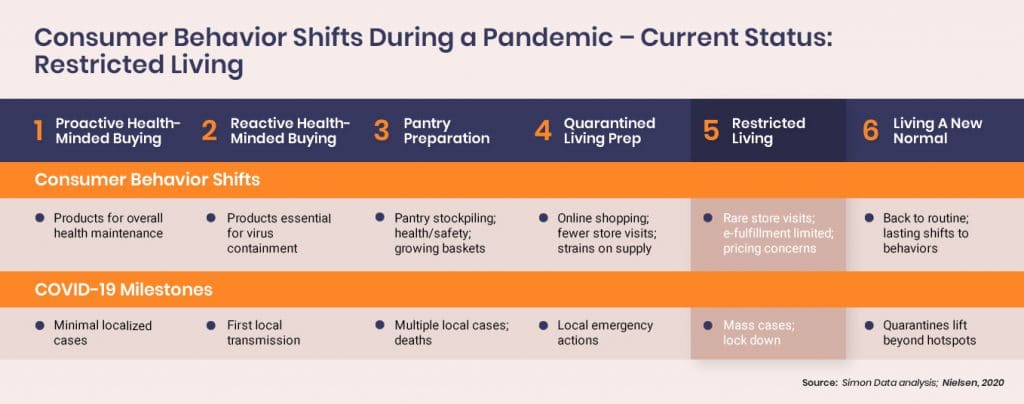How Should Marketers Respond to the Covid-19 Crisis?
After our first Covid-19 Response digest last week, many of you asked us fundamental questions about our views on what the Covid-19 impact on marketing will be, and what immediate course of actions marketers should take. We are trying to address these and other concerns in this and future newsletters Today we wanted to address some of the fundamentals by sharing three insights for the unfolding Covid-19:
- Scenarios for how the Covid-19 might evolve, with the ensuing overall costs for business and society, case Finland
- What is the likely Covid-19 impact on Marketing Budgets 2020-2021?
- What should marketers do right now? – Short term recommendations and immediate action (Q2-Q3/2020) for marketers
There are, at the time of writing, no reliable forecasts for the duration of the outbreak or whether economic recovery will be fast or slow. Chinese data is not fully applicable with multiple vortexes of escalating outbreaks in the EU and the US, with the rest of the world still to follow. The Covid economic impact is a function of time of lockdown measures with ensuing demand suppression and the scope of loss of overall consumption.
Sasu Ristimäki has built a scenario tool for estimating the cost of the lockdown measures. The overall costs vary from 6,2 billion € for a 45 day period to 13,7 billion for a 160 days of lockdown. An assessment by the Finnish Ministry of Social Affairs and Health says that the outbreak will last between 120 and 160 days, counting from March 1st. In a tweet.
What will happen to Marketing Budgets during and after the Covid-19 outbreak? Kim Weckström and Sasu Ristimäki have put the crisis in context and analyzed how marketing spend has developed in earlier economic downturns. The analysis should provide both context and guidance for marketing contingency planning in these times of high uncertainty.
Avaus has also prepared a set of recommendations based on a 120 day scenario where the Covid-19 outbreak will be contained by early Q3, while lockdown measures are gradually eased across Europe during the quarter. The full ramp up of business is expected early Q4 2020.
This scenario needs to be re-assessed on a daily basis, as epidemic data and forecasts are published. (see: Sasu Ristimäki: What are the costs of the lockdown in Finland? – Covid-19 macroeconomics for marketers).
Avaus recommendations for Short-Term action Q2-Q3/2020 – Ensure your room to maneuver after the immediate crises
1. Understand the behaviour shifts of your customers, at the different stages of the crisis
Create scenarios for how your customer needs and sentiments develop throughout and after the crisis. Customers expect marketers to help them adapt to the different phases of the crisis. As a consequence of the partial lockdown in Sweden and the full lockdown in Finland, consumers have moved from reactive stockpiling of necessities and health-related buying into a restrictive living phase while starting slowly to prepare for a new normal after the outbreak. All data sources available should be used to create a proper understanding of customers’ expectations. Marketing should react to identified needs proactively. The outcomes for your business and your customers as well will depend on your actions during the next critical months.

2. Trim operating cost to create room to maneuver
Your first priority should be to defend your present customer relations by all available means. As your sales, marketing and customer service resources will diminish while your physical interactions are on hold and channels remain shut down, you need to shift the available diminished resources to reflect the contingency. Focus on relevance, retention and service, not sales. Build on the emotional baseline for the near future. Intensify service & loyalty activities in the short term. Slash customer acquisition spend, media, agency, telesales, and focus on retention, service and be ready to initiate up and cross sell to existing customers.
(Avaus estimates that average Marketing spend will decrease with 15-25% in Sweden and Finland during 2020-2021, see Blog here. )
3. Demonstrate corporate citizenship, do not close communications down
Reconfigure your communications to address the emotional baseline of shared distress. Change your role from a seller and marketer to a corporate citizen, reach out, re-assess your value proposition for the community. Look for ways to stay relevant when customer demand for your products and services is disrupted, or has, in the worst case, temporarily disappeared. Your communications should demonstrate social contribution, create trust and enforce a shared anticipation for the resolution of the Covid-19 crisis.
4. Inhouse teams work with carefully selected partners
Realign your inhouse teams, complemented by carefully selected external partners focusing on resolution of urgent customer, personnel and partner needs. When lacking physical touchpoints, your team should compensate with the same level or higher activity level as before the crisis in online channels.
5. Defend your development budgets
Defend development initiatives, that will improve competitiveness in the immediate aftermath of the crisis, should be defended. Your primary focus should be capabilities that enable the marketing org to do more with less. Development focus should center around data & automation capabilities for customer management, in addressable channels, where you can reach each customer individually.
Recommendations for Mind-Term Q3/Q4/2020 and Long-Term 2021 onwards will follow shortly.